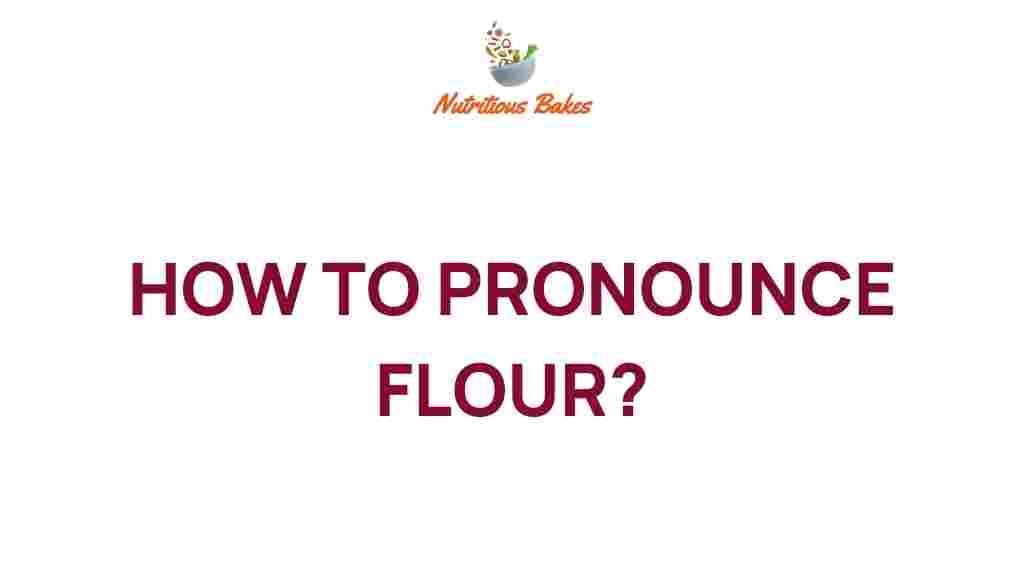Flour Pronunciation: Mastering the Basics of Culinary Terms
Have you ever found yourself in a cooking class or a culinary conversation and hesitated when it came time to say the word “flour”? You’re not alone. Many people struggle with the pronunciation of certain culinary terms, and “flour” is one of the most common offenders. In this article, we will explore the surprising secrets behind how to pronounce flour correctly, while also delving into useful language tips, phonetics, and cooking terminology.
Understanding Flour Pronunciation
Pronouncing “flour” correctly is essential for anyone involved in food vocabulary, whether you’re a budding chef, a language learner, or simply someone who enjoys cooking. The word “flour” is pronounced as /flaʊər/ in phonetic symbols. This pronunciation can vary slightly based on regional accents, but understanding the basics will help you communicate more effectively.
The Importance of Pronunciation in Culinary Terms
In the culinary world, precise language is crucial. Mispronouncing terms can lead to misunderstandings, especially in professional kitchens or cooking classes. Here are a few reasons why mastering flour pronunciation and other culinary terms is vital:
- Effective Communication: Correct pronunciation fosters clear communication among chefs and home cooks alike.
- Building Confidence: Being able to pronounce terms correctly boosts your confidence in the kitchen.
- Avoiding Misinterpretations: Mispronouncing a term could lead to using the wrong ingredient or technique.
Step-by-Step Guide to Pronouncing Flour
Now that you understand the significance of proper pronunciation, let’s break down how to pronounce “flour” step by step.
Step 1: Break It Down Phonetically
The phonetic breakdown of “flour” is /flaʊər/. Here’s how to pronounce it:
- “F” sound: Start with the “f” sound, as in fish.
- “L” sound: Next, add the “l” sound, as in light.
- “OU” sound: Then, form the diphthong “ou,” which sounds like “ow” in how.
- “R” sound: Finally, finish with the “r” sound, lightly pronounced.
Step 2: Practice with Similar Words
To master the pronunciation of flour, it helps to practice with similar words. Here are a few:
- Flower: Pronounced /ˈflaʊər/, similar pronunciation but a different meaning.
- Power: Also pronounced /ˈpaʊər/, which can help reinforce the diphthong sound.
- Hour: Another word to practice the “ou” sound, pronounced /aʊər/.
Step 3: Use Online Resources
There are many online resources that provide audio examples of word pronunciations. Websites like Dictionary.com can be useful for hearing how “flour” and other culinary terms are pronounced by native speakers.
Tips for Language Learners
If you’re a language learner, here are some additional tips for mastering flour pronunciation and other culinary terms:
- Listen and Repeat: Find cooking videos or podcasts where chefs discuss recipes and listen to their pronunciation.
- Join a Cooking Class: Practicing in a group setting can provide valuable feedback and help improve your pronunciation.
- Record Yourself: Hearing your own voice can help identify areas for improvement.
Troubleshooting Common Pronunciation Mistakes
Even with practice, you might encounter some common difficulties when pronouncing “flour.” Here are a few troubleshooting tips:
1. Diphthong Confusion
One of the main challenges is the diphthong “ou.” If you find it hard to transition smoothly between the sounds, try elongating the “ow” sound before adding the “r.”
2. Regional Variations
Be aware that pronunciation can vary by region. For example, some may pronounce it more like /flɔːr/. Listen to local speakers or culinary professionals to adapt to your environment.
3. Overemphasis on the “R”
In some accents, the “r” sound may be more prominent. Focus on softening the “r” at the end to avoid sounding too harsh.
Related Culinary Terms to Enhance Your Vocabulary
Expanding your food vocabulary can enhance your culinary conversations. Here are some related terms you should know:
- Flourish: To grow or develop in a healthy way, often used in culinary contexts to describe ingredients.
- Flour Tortilla: A type of flatbread made with flour, commonly used in Mexican cuisine.
- Flour Sifter: A kitchen tool used to aerate and combine dry ingredients.
Conclusion: Flour Pronunciation and Beyond
In conclusion, mastering the pronunciation of flour and other culinary terms is essential for effective communication in the kitchen. By understanding the phonetics, practicing regularly, and utilizing available resources, you can enhance your culinary vocabulary and boost your confidence in cooking. Remember, pronunciation is just one piece of the puzzle; the more you learn about cooking terminology, the more skilled you’ll become in the culinary arts.
Whether you’re a seasoned chef or a language learner, focusing on flour pronunciation and expanding your food vocabulary will serve you well in your culinary journey. So, the next time you’re in the kitchen or at a cooking class, you’ll be ready to pronounce “flour” with confidence!
For more language tips and cooking advice, make sure to check out our culinary language guide and keep refining your skills!
This article is in the category Tips and created by NutritiousBakes Team
